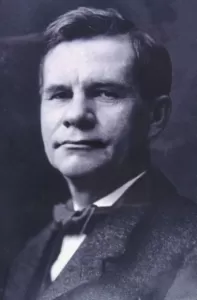The Legend of Gustav and Charles Stickley
This article has been republished. Original date of publication: June 22nd, 2013.

Gustav Stickley
Readers know that last year, I had been traveling around the western North Carolina foothills, following in the footsteps of Asheville’s literary guest in 1935 and 1936 — F. Scott Fitzgerald.
In one of my past trips, while driving the backroads of western North Carolina, I took some time to check out several antiques shops along the way. Although I never expected to find much in the way of high quality Arts and Crafts in this area, I often remind myself that the only people who don’t find anything are the ones who quit looking.
And so it was that I came face to face in Blue Ridge Mountains with both Charles and Gustav Stickley.
The only problem was that they were both in the same piece of furniture.
Much as been made over the years of the “feuding” between the five Stickley brothers — Albert, Charles, Gustav, Leopold, and John. Much, as it turns out, was exaggerated. Certainly, take five young, strong-willed descendents of German ancestry and put them all together in a small furniture shop and you’re likely to find some dissention. And in their case the brothers did eventually form four separate and sometimes competing Arts and Crafts furniture businesses.
And was there the occasional sniping at each other?
Certainly.
But as researchers Michael and Jill Thomas-Clark and David Cathers discovered, they were also just as apt to have Sunday dinner together.
Or, as in the case of the Arts and Crafts china cabinet I discovered, to combine their creative skills.
I stood there, staring at what I knew from more than 30 years experience was not a Gustav Stickley china cabinet, but that had three Gustav Stickley hammered pulls on the doors. I poured over the piece, hoping to find a decal or brand, but came up empty.
It took a couple of days of thinking about it to make the trip back down to check it out once more, and, as it turned out, to load it into the back of my pickup and drive it home. Once back here I pulled out my strongest spotlight and went over it inch by inch, but, alas, no shopmark. Next I started digging through my bookcases looking for a Turn of the Century Publishing reprint of a 1911 catalog I hadn’t read for years: “Modern Craft Style By Charles Stickley.”
There it was: “China Cabinet No. 1915. Price $64.”
A dead ringer. A perfect match.
Proof, once again, that Gustav Stickley was more than willing to share his hardware with Charles Stickley, who most likely did not have a metalsmith shop of his own and preferred not to buy stamped or molded door and drawer pulls from one of the Grand Rapids hardware firms.
Another good reminder than these were far more than just names in history, they were real people, including brothers who watched out for each other.
Until next Monday,
Consider no day lost….

Bruce
For more on Charles Stickley, see this week’s Collector’s Guide, and go to http://www.turnofthecenturyeditions.com.
